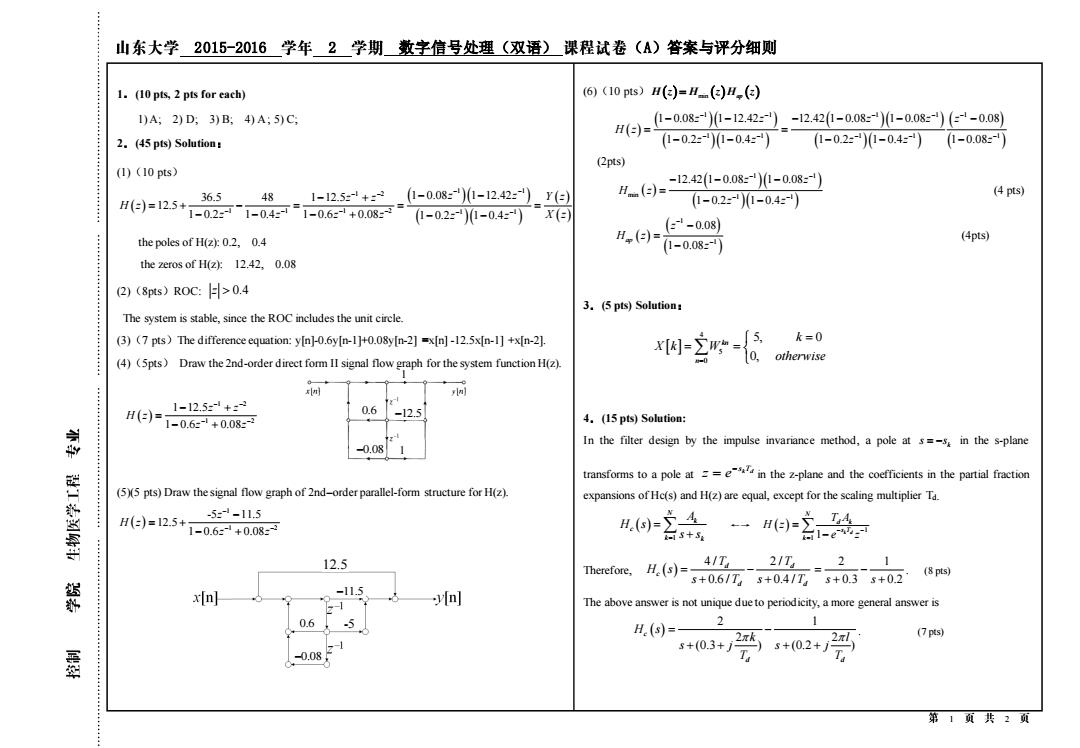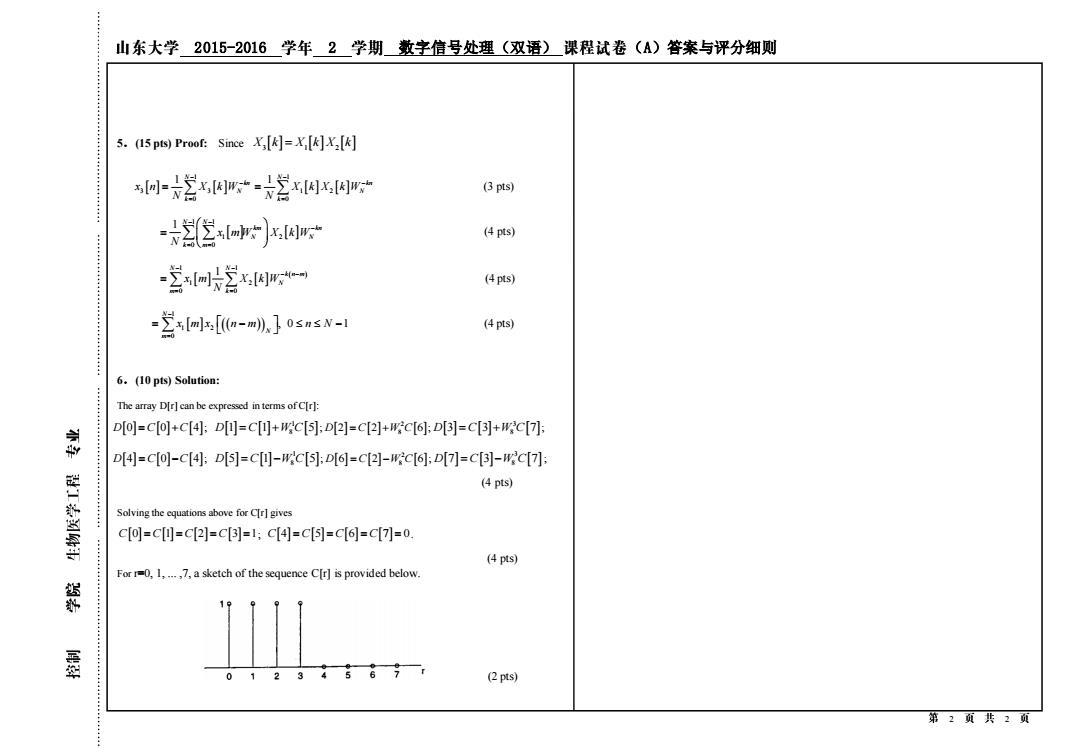
山东大学2015-2016学年2学期数字信号处理(双语)课程试卷()答案与评分细则 1.(10 pts,2 pts for each) (6)(I0pts)H()=H()H,() 1)A;2)D;3)B:4)A;5)C, H(e)= 1-0.08=-)0-1242-)_-12421-0.08-)0-0.08=-)(-1-0.08) 2.(45 pts)Solution: (1-0.2-)1-0.4-) (1-0.200-0.4) (1-0.08=-) (2pts) (I)(10pts) -12.421-0.08=-)1-0.08-)) 36.5 48 1-12.52+s-2 (1-0.08=-)1-1242:-)y包 H.()= (4 pts) H(e)=12.5+ *1-0.2-1-0.42-1-0.6:+0.08= (1-0.2-)1-0.4-) (-0.2)0-0.4-)X(E H(日 (-0.08) the poles of H(z):0.2,0.4 (1-0.08=- (4pts) the zeros of H(2):12.42,0.08 (2)(8pts)ROC:>0.4 3.(5 pts)Solution: The system is stable,since the ROC includes the unit circle. (3)(7 pts)The difference equation:y[n]-0.6y[n-1]+0.08y[n-2]=x[n]-12.5x[n-1]+x[n-2]. -2- 5 k=0 otherwise (4)(5pts)Draw the 2nd-order direct form II signal flow graph for the system function H(z). H(e)= 1-12.51+s 0.6 -12.5 1-0.6:+0.08- 4.(15 pts)Solution: -0.081 In the filter design by the impulse invariance method,a pole at s=-s in the s-plane transforms to a pole atin the z-plane and the coefficients in the partial fraction (5)(5 pts)Draw the signal flow graph of 2nd-order parallel-form structure for H(z). expansions of Hc(s)and H(z)are equal,except for the scaling multiplier Ta. H(e)=12.5+ -5-1-11.5 1-0.621+0.08- s+3 1-e 12.5 1 Therefore, s+0.61T3+0.41Ts+0.3s+0.2 (8 pts) 器 x[n] -11.5 2-1 ▣ The above answer is not unique due to periodicity,a more general answer is 0.6 H()= 1 s+(0.3+ 2k)s+0.2+ 2πl、 (7 pts) 暴 -0.08 第1页共2页
2015-2016 2 数字信号处理(双语) (A)答案与评分细则 1 2 1.(10 pts, 2 pts for each) 1) A; 2) D; 3) B; 4) A ; 5) C; 2.(45 pts) Solution: (1)(10 pts) ( ) ( )( ) ( )( ) ( ) ( ) 1 1 1 2 1 1 1 2 1 1 36.5 48 1 12.5 1 0.08 1 12.42 12.5 1 0.2 1 0.4 1 0.6 0.08 1 0.2 1 0.4 z z z z Y z H z z z z z z z X z − − − − − − − − − − − + − − = + − = = = − − − + − − the poles of H(z): 0.2, 0.4 the zeros of H(z): 12.42, 0.08 (2)(8pts)ROC: z 0.4 The system is stable, since the ROC includes the unit circle. (3)(7 pts)The difference equation: y[n]-0.6y[n-1]+0.08y[n-2] =x[n] -12.5x[n-1] +x[n-2]. (4)(5pts) Draw the 2nd-order direct form II signal flow graph for the system function H(z). ( ) 1 2 1 2 1 12.5 1 0.6 0.08 z z H z z z − − − − − + = − + (5)(5 pts) Draw the signal flow graph of 2nd–order parallel-form structure for H(z). ( ) 1 1 2 -5 11.5 12.5 1 0.6 0.08 z H z z z − − − − = + − + (6)(10 pts) ( ) min ( ) ( ) H z H z H z = ap ( ) ( )( ) ( )( ) ( )( ) ( )( ) ( ) ( ) 1 1 1 1 1 1 1 1 1 1 1 0.08 1 12.42 12.42 1 0.08 1 0.08 0.08 1 0.2 1 0.4 1 0.2 1 0.4 1 0.08 z z z z z H z z z z z z − − − − − − − − − − − − − − − − = = − − − − − (2pts) ( ) ( )( ) ( )( ) 1 1 min 1 1 12.42 1 0.08 1 0.08 1 0.2 1 0.4 z z H z z z − − − − − − − = − − (4 pts) ( ) ( ) ( ) 1 1 0.08 1 0.08 ap z H z z − − − = − (4pts) 3.(5 pts) Solution: 4.(15 pts) Solution: In the filter design by the impulse invariance method, a pole at k s s =− in the s-plane transforms to a pole at k d s T z e − = in the z-plane and the coefficients in the partial fraction expansions of Hc(s) and H(z) are equal, except for the scaling multiplier Td. ( ) 1 N k c k k A H s = s s = + ←→ ( ) 1 1 1 k d N d k s T k T A H z e z − − = = − Therefore, ( ) 4 / 2 / 0.6 / 0.4 / d d c d d T T H s s T s T = − + + 2 1 s s 0.3 0.2 = − + + . (8 pts) The above answer is not unique due to periodicity, a more general answer is ( ) 2 1 2 2 (0.3 ) (0.2 ) c d d H s k l s j s j T T = − + + + + . (7 pts) 12.5−11.5 0.6 -5 −0.08 4 5 0 5, 0 0, kn n k X k W = otherwise = = = 1 −0.08 −12.5 1 0.6

山东大学2015-2016学年2学期数字信号处理(双语)课程试卷()答案与评分细则 5.(15 pts)Proof:Since[]] =2x时=差xw (3 pts) (4 pts) : x时 -星片2xs (4pts) -2s[a-儿]0sasw-l (4 pts) 6.(10 pts)Solution: The array DIr]can be expressed in terms of C[r]: D[o=C[0+c4:D[0=C[刊+C[:D[2=C[2]+wC[D[3)=C[3+wc[ D[4=Co-C4:D[=C-C[:D[=C2-c[:D[]=C[-wC[]: (4 pts) Solving the equations above for CIr]gives c[0=c[0=c2]=c[3-1:c[4-C-c=c]=o. (4 pts) For r,1...,a sketch of the sequence C[r]is provided below. 器 i 12 (2pts) 第2页共2页
2015-2016 2 数字信号处理(双语) (A)答案与评分细则 2 2 5.(15 pts) Proof: Since X k X k X k 3 1 2 = 1 3 3 0 1 N kn N k x n X k W N − − = = 1 1 2 0 1 N kn N k X k X k W N − − = = (3 pts) 1 1 1 2 0 0 1 N N km kn N N k m x m W X k W N − − − = = = (4 pts) ( ) 1 1 1 2 0 0 1 N N k n m N m k x m X k W N − − − − = = = (4 pts) (( )) 1 1 2 0 , 0 1 N N m x m x n m n N − = = − − (4 pts) 6.(10 pts) Solution: The array D[r] can be expressed in terms of C[r]: D C C 0 0 4 = + ; 1 8 D C W C 1 1 5 = + ; 2 8 D C W C 2 2 6 = + ; 3 8 D C W C 3 3 7 = + ; D C C 4 0 4 = − ; 1 8 D C W C 5 1 5 = − ; 2 8 D C W C 6 2 6 = − ; 3 8 D C W C 7 3 7 = − ; (4 pts) Solving the equations above for C[r] gives C C C C 0 1 2 3 1 = = = = ; C C C C 4 5 6 7 0 = = = = . (4 pts) For r=0, 1, ... ,7, a sketch of the sequence C[r] is provided below. (2 pts)